Low Distortion of Noise Filter Realization with 6.34 V/μs Fast Slew Rate and 120 mVp-p Output Noise Signal
Abstract
1. Introduction
2. Mathematics Background
3. Design Method
3.1. Circuit Design: Retention of the Real Signal
3.2. Circuit Design: Capturing of Upper and Lower Envelopes
- VM is the maximum output voltage and VL is the minimum output voltage.
- Vr is the ripple voltage.
- is the time for discharging and is the discharging period.
- Tp is the period of the ripple.
3.3. Circuit Design: Fast Charge and Discharge Design
4. Experiment Results
4.1. Circuit Simulations
4.1.1. Low-Pass Filter
- n = the order of the filter.
- = the radian frequency which is equal to 2πf.
- = cut off radian frequency.
- = cutoff frequency = frequency at which the gain drops to −3 dB.
- is the DC gain (zero frequency gain).
4.1.2. Frequency Response Analysis
4.1.3. Square and Sine Wave Response
4.1.4. Noise Attenuation Analysis
4.1.5. Response Speed Analysis
- = Time from 10% Vp-p rise to 90% Vp-p.
- = Time from 90% Vp-p fall to 10% Vp-p.
4.1.6. Fourier Amplitude Spectrum Analysis
4.1.7. Phase Response Analysis
4.2. Circuit Implementation
5. Conclusions
5.1. Technique Features
5.2. Future Prospects
Author Contributions
Funding
Institutional Review Board Statement
Informed Consent Statement
Data Availability Statement
Conflicts of Interest
References
- Chen, Y.T. The Implementations for Nise Cancellation for ECG Devices—A High Computational Efficiency Digital-Filter Design Using Pole-Zero Sensitivity Minimization Approach. Master’s Thesis, Asia University, Taichung, Taiwan, 28 June 2016. [Google Scholar]
- Webster, J.G. Medical Instrumentation Application and Design; Wiley: Hoboken, NJ, USA, 1998. [Google Scholar]
- Bear, M.F.; Connors, B.W.; Paradiso, M.A. Neuroscience: Exploring the Brain; Lippincott Williams & Williams Inc.: Baltimore, MA, USA, 1996. [Google Scholar]
- Wise, K.D. A Multi-Channel Microprobe for Biopotential Recording. Ph.D. Thesis, Stanford University, Stanford, CA, USA, May 1969. [Google Scholar]
- Supuk, T.G.; Skelin, A.K.; Cic, M. Design, development and testing of a low-cost sEMG system and its use in recording muscle activity in human gait. Sensors 2014, 14, 8235–8258. [Google Scholar] [CrossRef] [PubMed]
- Chen, S.W.; Chen, Y.H. Hardware design and implementation of a wavelet de-noising procedure for medical signal preprocessing. Sensors 2015, 15, 26396–26414. [Google Scholar] [CrossRef] [PubMed]
- Hossain Mishu, M.M.; Aowlad Hossain, A.B.M.; Ahmed Emon, M.E. Denoising of ECG signals using dual tree complex wavelet transform. In Proceedings of the 17th International Conference on Computer and Information Technology, Dhaka, Bangladesh, 22–23 December 2014. [Google Scholar]
- Jiao, Z.; Liu, B.; Liu, E.; Yue, Y. Low-pass parabolic FFT filter for airborne and satellite lidar signal processing. Sensors 2015, 15, 26085–26095. [Google Scholar] [CrossRef] [PubMed]
- Wu, I.; Ohta, H.; Gotoh, K. Characteristics of radiation noise from an LED lamp and its effect on the BER performance of an OFDM system for DTTB. IEEE Trans. Electromagn. Compat. 2014, 56, 132–142. [Google Scholar] [CrossRef]
- Ishida, K.; Arie, S.; Wu, I.; Gotoh, K.; Matsumoto, Y. Evaluation of electromagnetic noise radiated from tube-Type led lamps and its effect on wireless medical telemetry systems. In Proceedings of the 2019 International Symposium on Electromagnetic Compatibility, Barcelona, Spain, 2–6 September 2019. [Google Scholar]
- Razavi, B. Design of Analog CMOS Integrated Circuits; McGraw-Hill Press: New York, NY, USA, 2001. [Google Scholar]
- Motchenbacher, C.D.; Fitchen, F.C. Low-Noise Electronic Design; Wiley Press: New York, NY, USA, 1973. [Google Scholar]
- Neamen, D.A. Electronic Circuit Analysis and Design, 2nd ed.; McGraw–Hill Press: New York, NY, USA, 2001. [Google Scholar]
- Liu, L.; Ren, J.; Jwo, K.W.; Zhang, Y.; Li, X. Low distortion quick response noise filter realized with average peaks method. J. Harbin Inst. Technol. 2016, 23, 39–44. [Google Scholar]
- Lin, Z.C. A Low-Pass Filter Realization Based on Active Adjustable Capacitor Multiplier Circuit. Master’s Thesis, National Kaohsiung University of Applied Sciences, Kaohsiung, Taiwan, 29 June 2012. [Google Scholar]
- Lin, C.C. Design and Synthesis of High-Power Low-Pass Filters and Broadband Baluns. Master’s Thesis, National Chaio Tung University, Hsinchu, Taiwan, July 2009. [Google Scholar]
- Chang, C.W. ECG Signal Transmission by Using WiFi Networks. Master’s Thesis, Chung Hua University, Hsinchu, Taiwan, August 2017. [Google Scholar]
- Jung, W. Analog Devices, Op Amp Applications Handbook, 1st ed.; Elsevier: Oxford, UK, 2005; Available online: https://www.analog.com/en/education/education-library/op-amp-applications-handbook.html (accessed on 29 December 2020).
- Tolstov, G.P. Fourier Series; Courier-Dover Press: New York, NY, USA, 1976; ISBN 0-486-63317-9. [Google Scholar]
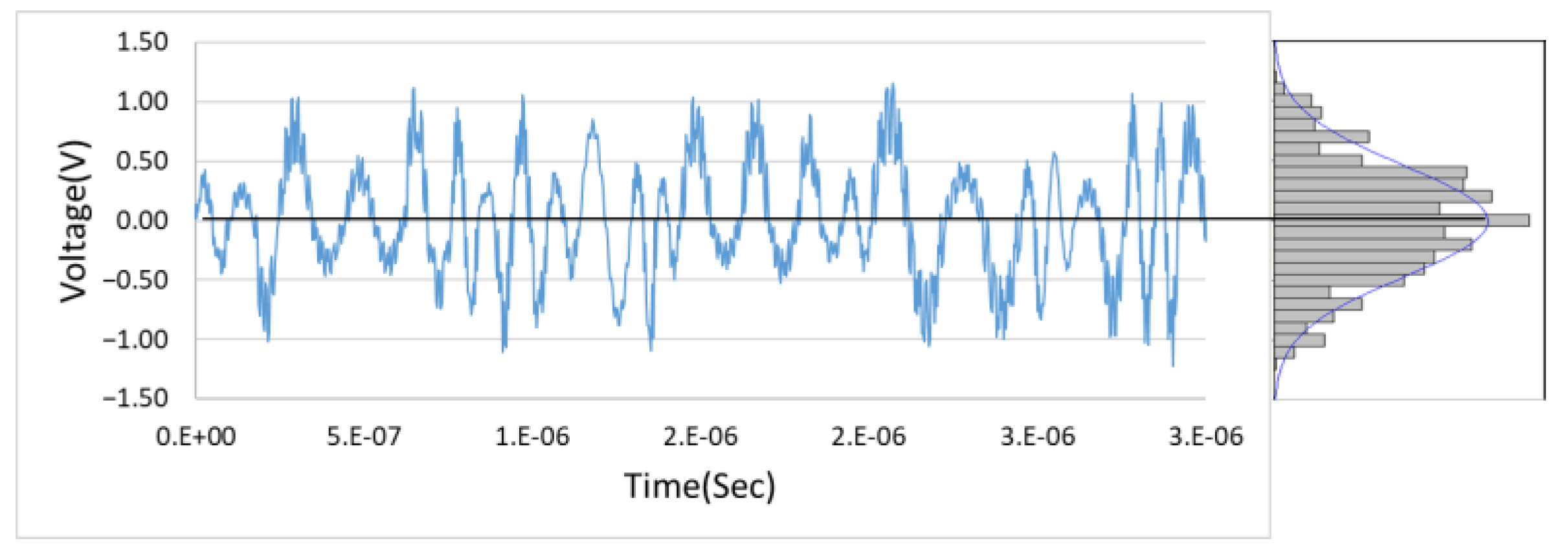

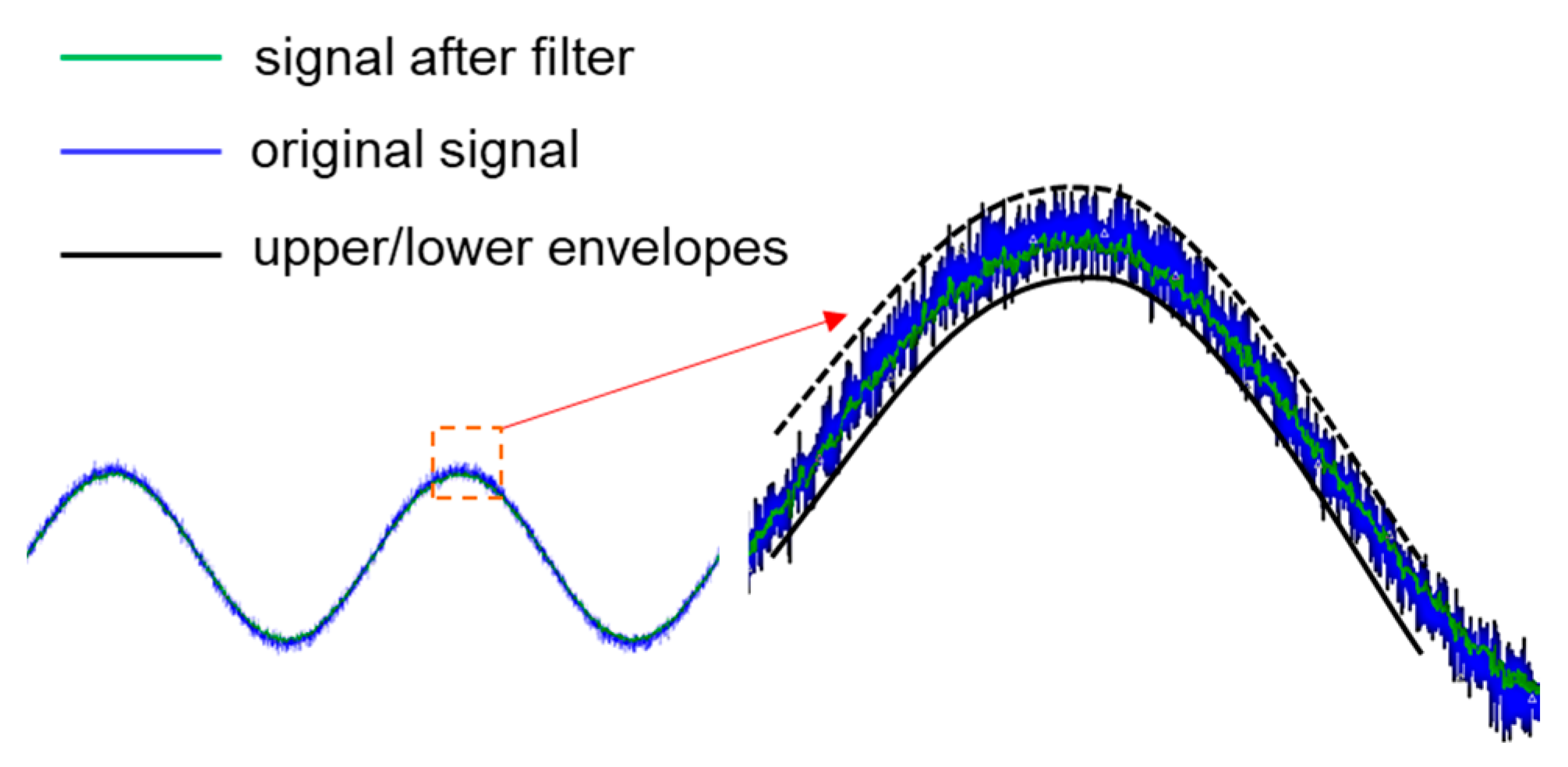

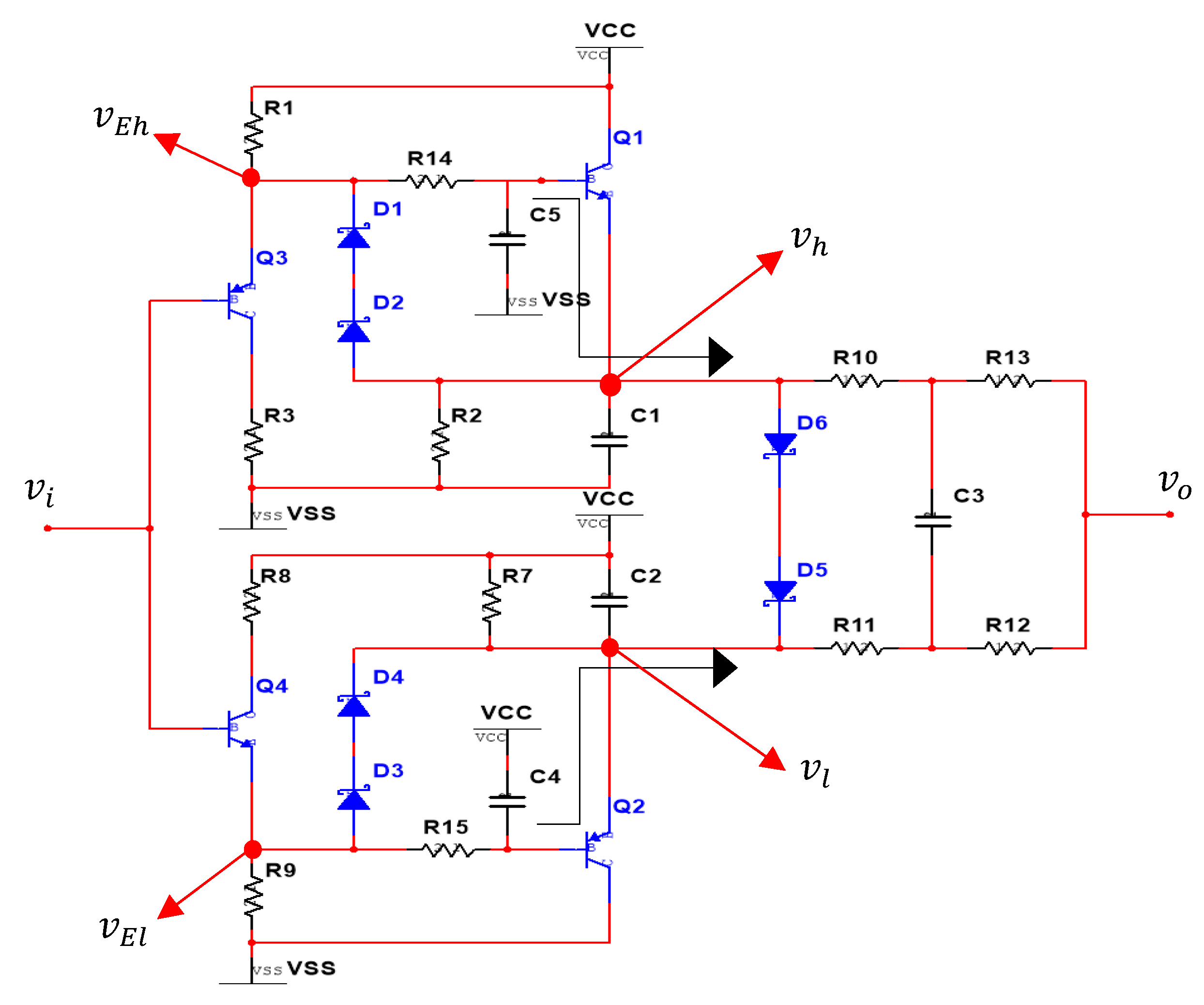
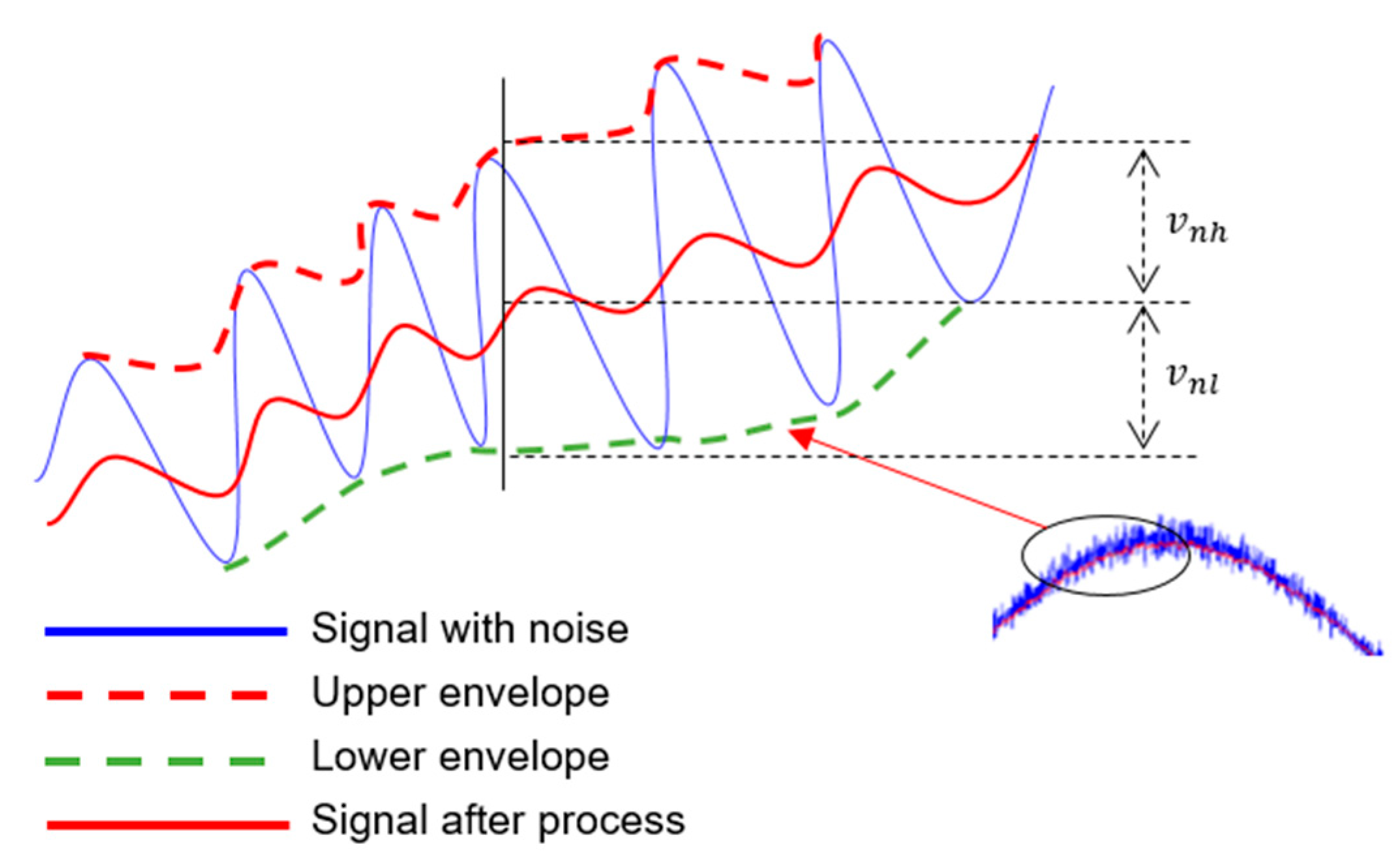
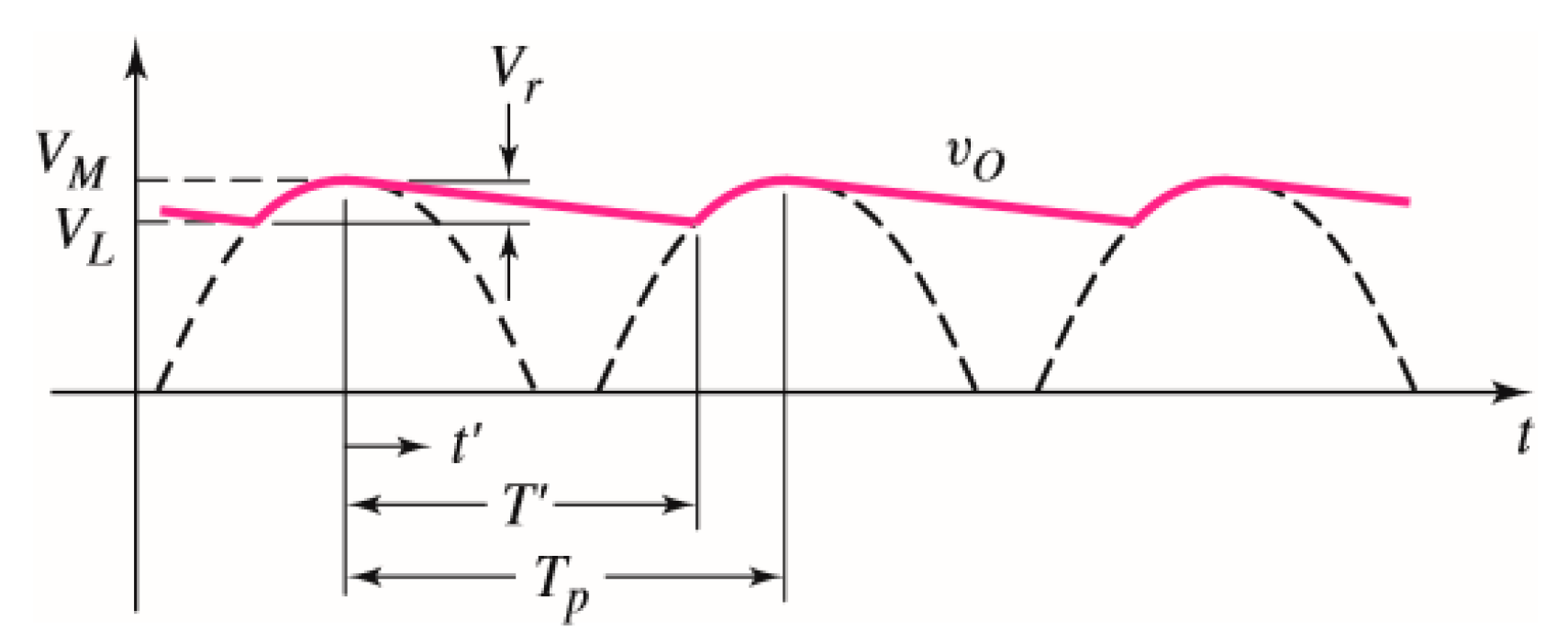



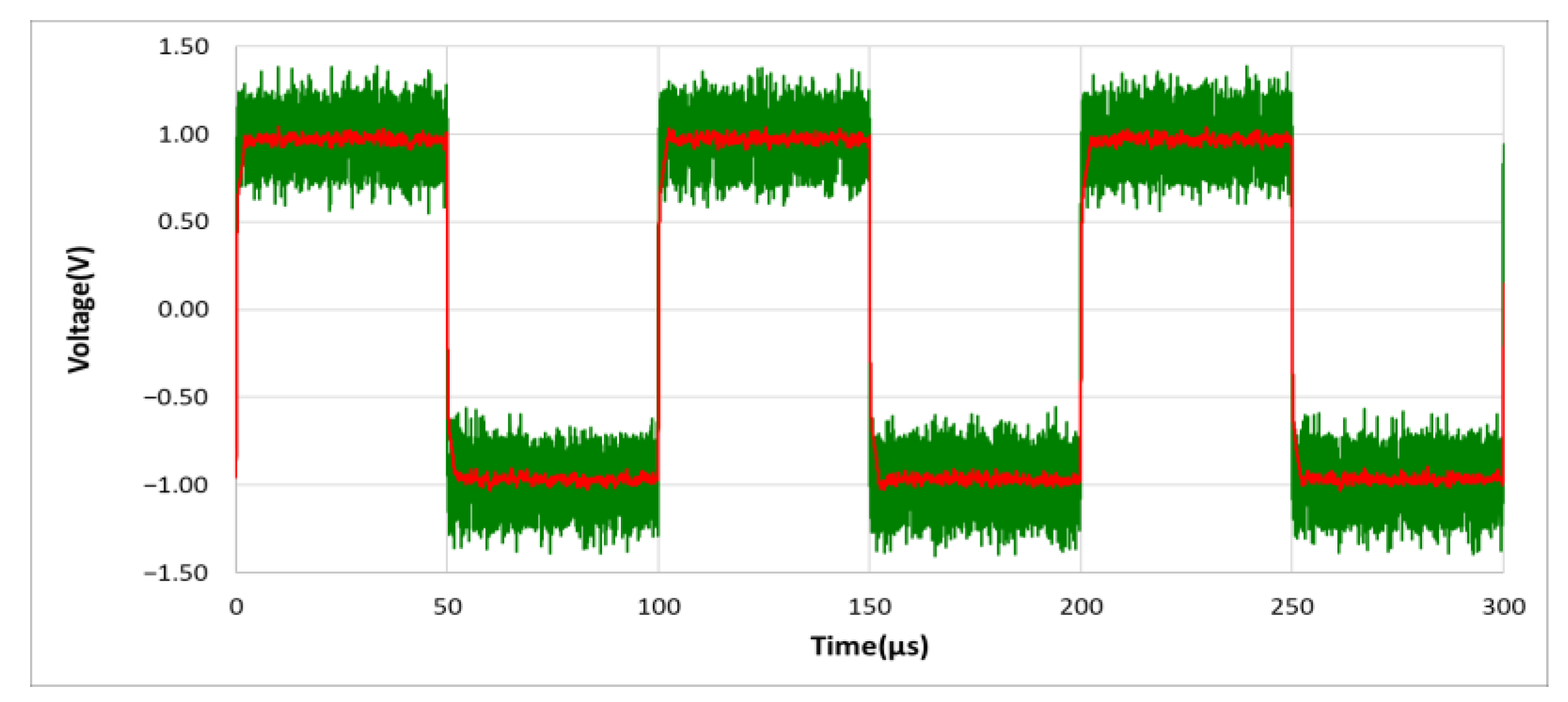
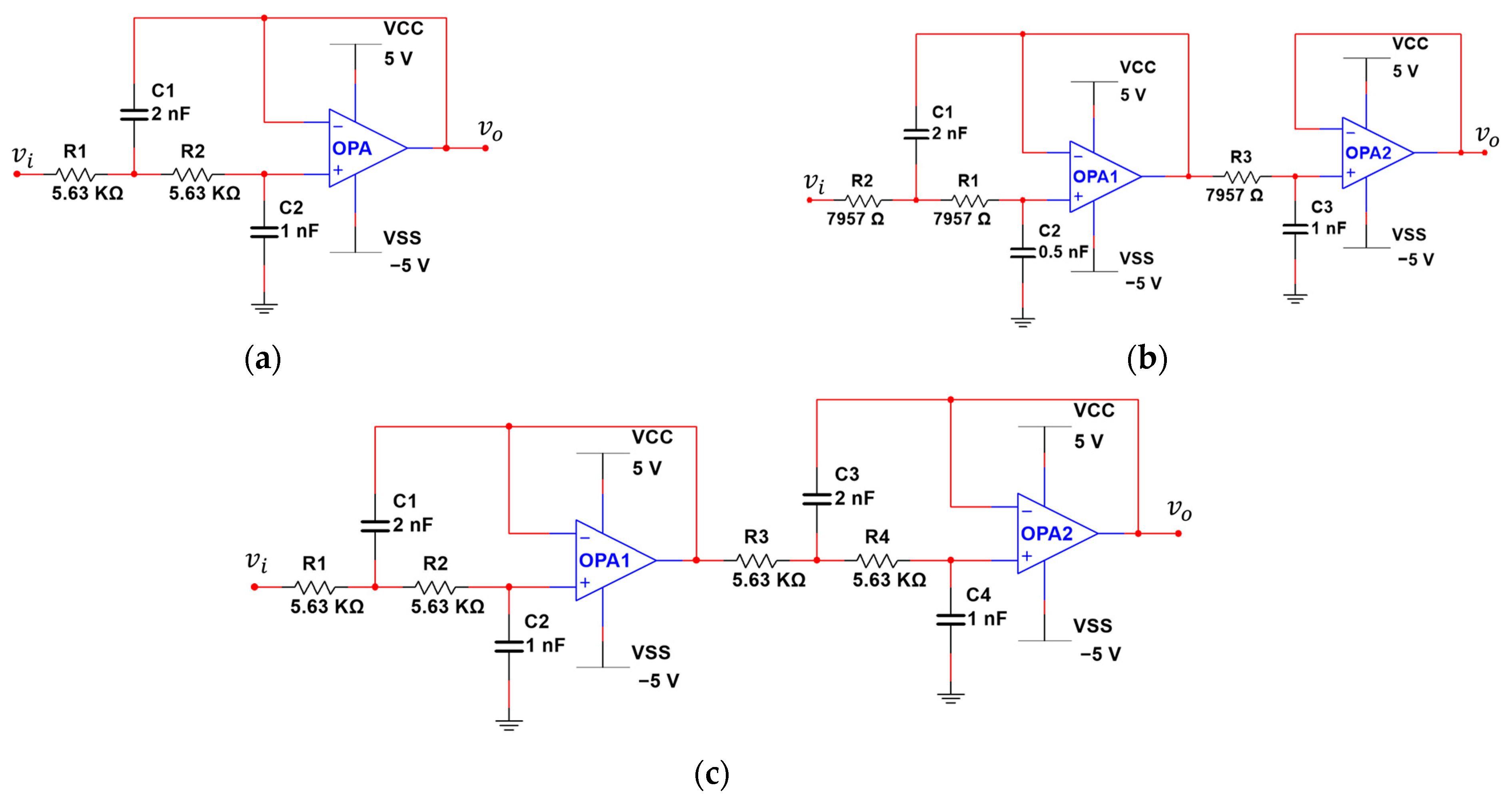
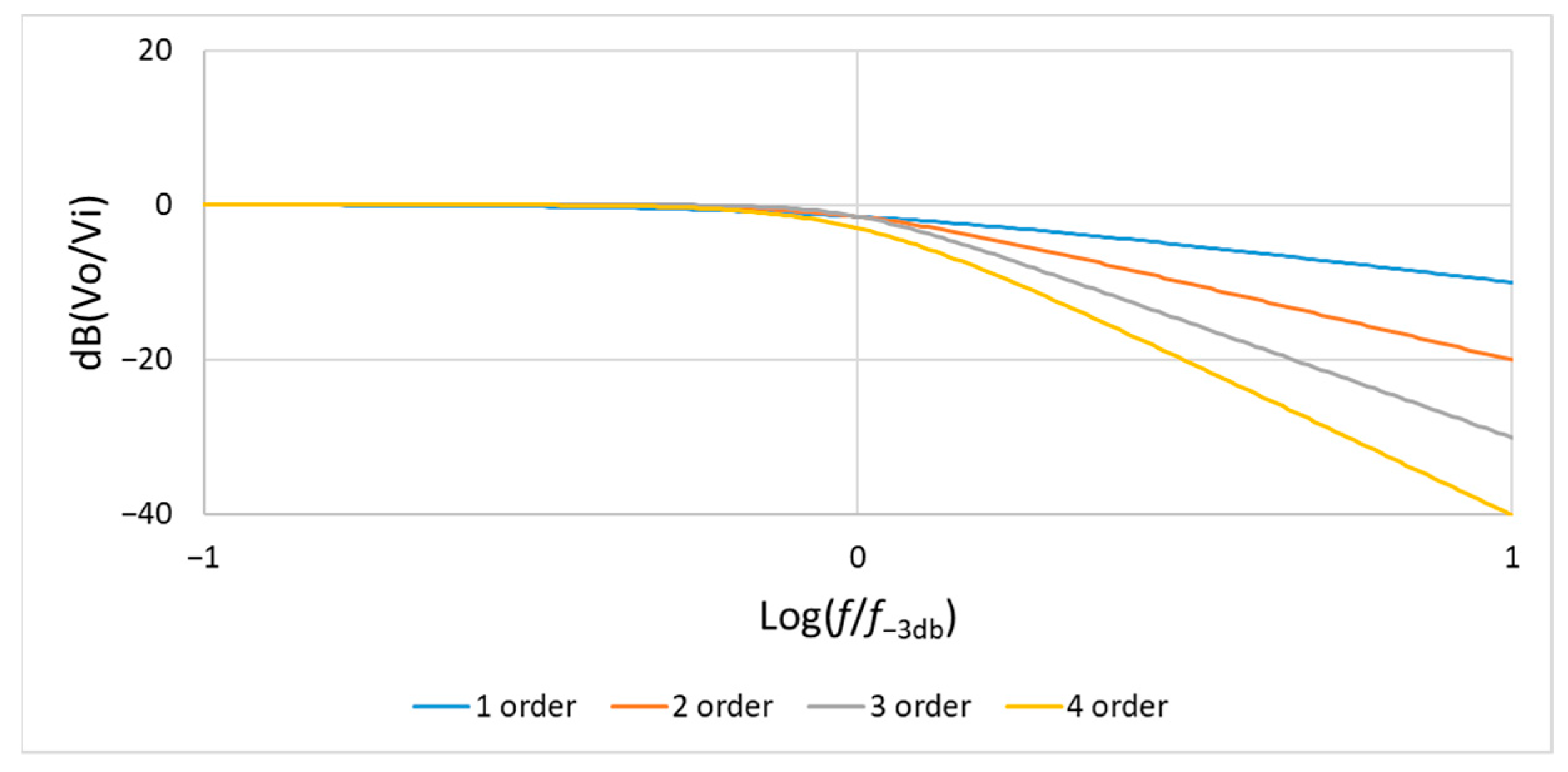


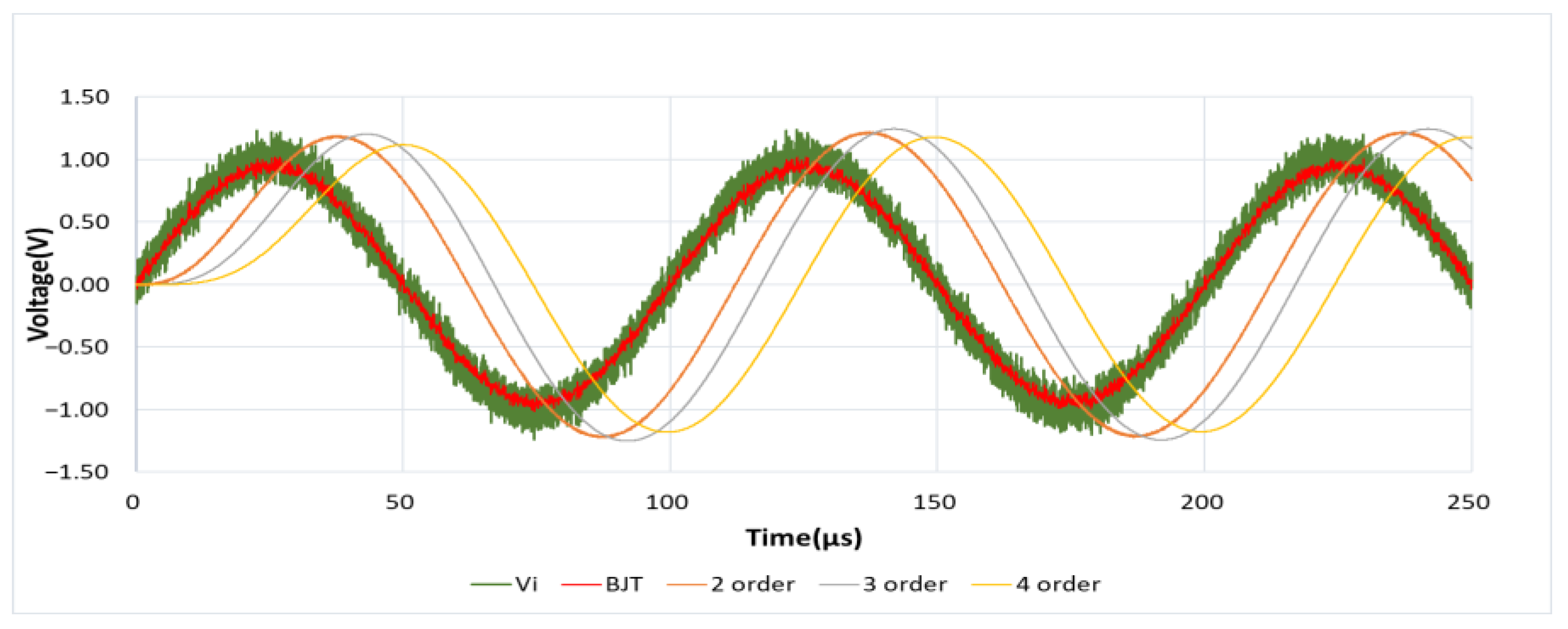
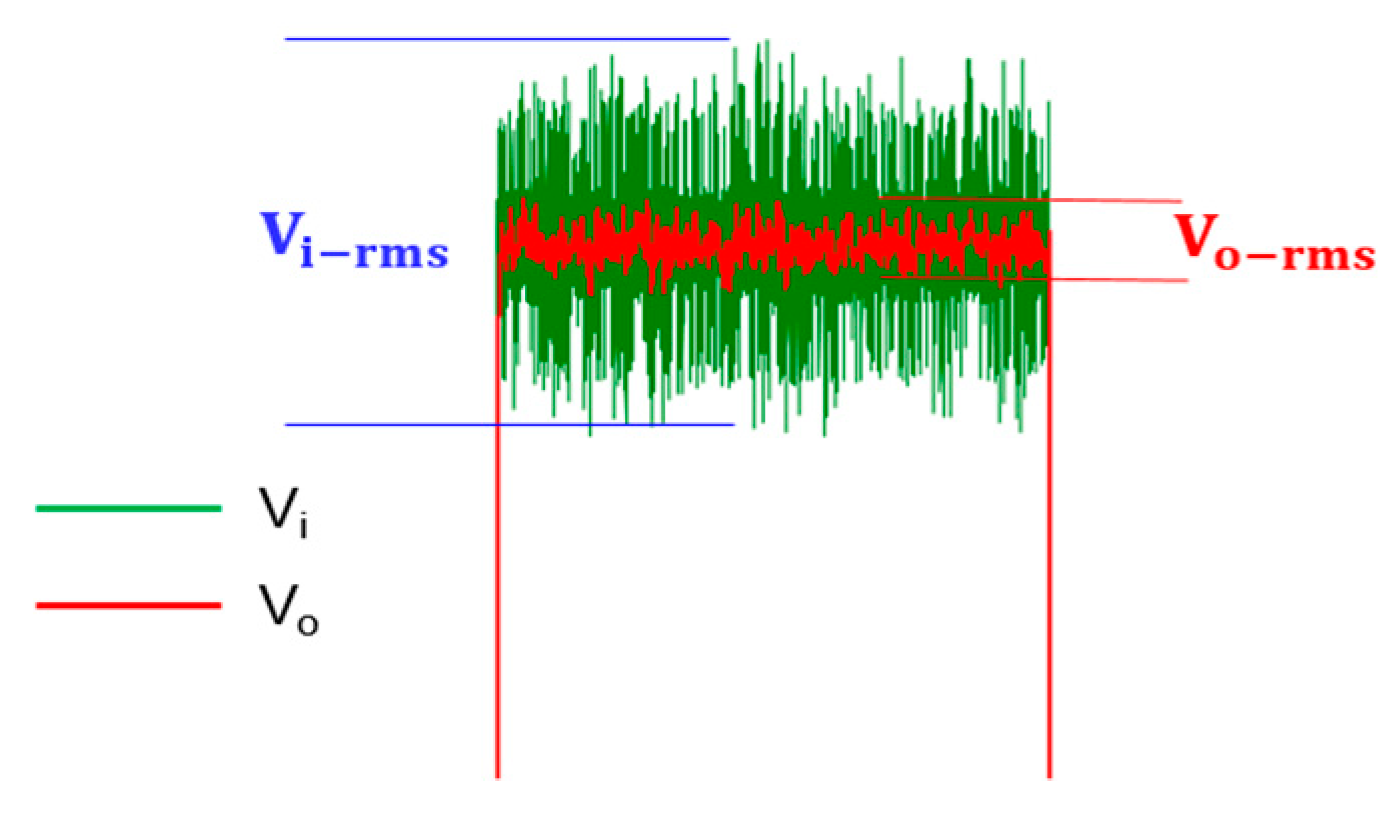






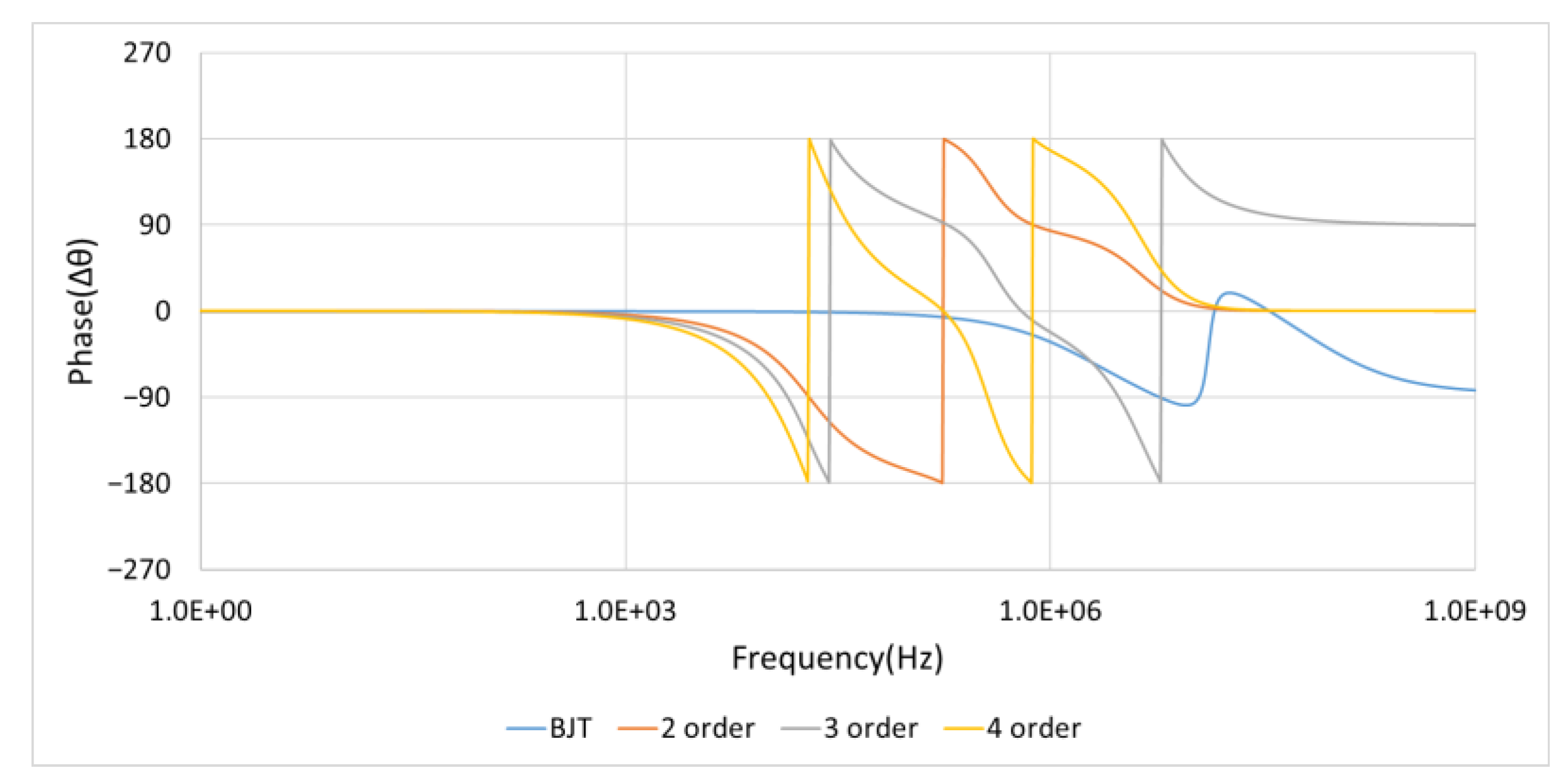

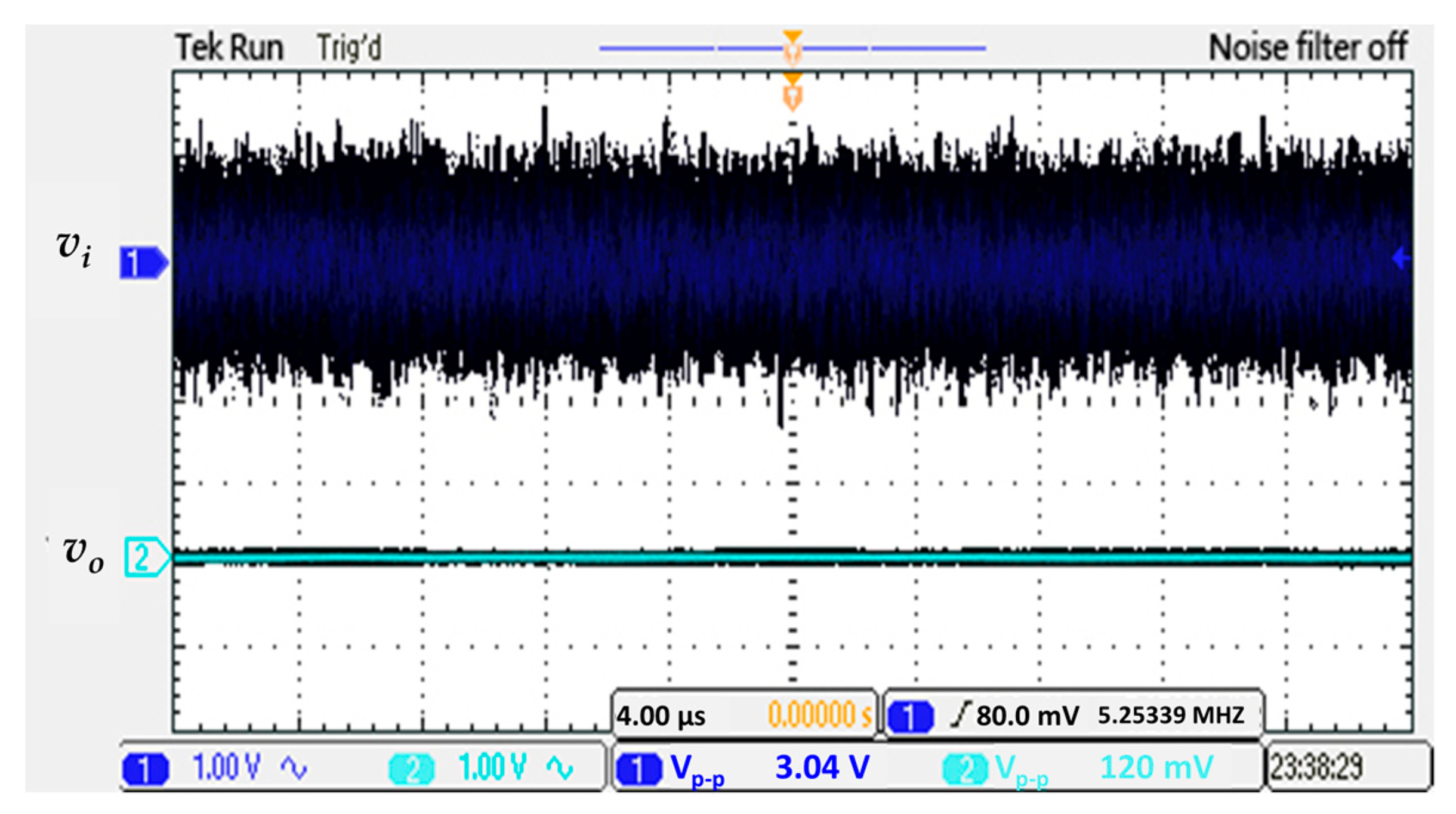
| Frequency | BJT | 2 Order | 3 Order | 4 Order |
|---|---|---|---|---|
| 1 KHz | 0 dB | 0 dB | 0 dB | 0 dB |
| 10 KHz | 0 dB | 0 dB | 0 dB | 0 dB |
| 200 KHz | 0 dB | −40 dB | −60 dB | −80 dB |
| 1 MHz | −1 dB | −42 dB | −78 dB | −84 dB |
| 0.081 V | 0.241 V | 0.486 V | |
| 0.019 V | 0.057 V | 0.114 V |
| Items | ΔTup (μs) | ΔTDown (μs) |
|---|---|---|
| BJT | 0.27 | 0.27 |
| 2 order | 25.48 | 25.47 |
| 3 order | 31.57 | 31.53 |
| 4 order | 33.69 | 33.63 |
| Frequency | BJT | 2 Order | 3 Order | 4 Order | |
|---|---|---|---|---|---|
| 10 KHz | 1.25896 | 1.20108 | 1.54432 | 1.58431 | 1.5003 |
| 30 KHz | 0.41925 | 0.401337 | 0.212284 | 0.148126 | 0.085771 |
| 50 KHz | 0.25305 | 0.24055 | 0.049239 | 0.019903 | 0.007709 |
| 70 KHz | 0.180795 | 0.171364 | 0.017986 | 0.005179 | 0.001454 |
| Frequency | BJT | 2 Order | 3 Order | 4 Order |
|---|---|---|---|---|
| 1 KHz | −0.04° | −5.09° | −7.63° | −10.16° |
| 10 KHz | −0.36° | −55.77° | −79.56° | −111.17° |
| 100 KHz | −3.43° | −170.14° | 110.90° | 19.75° |
| 1 MHz | −34.36° | 83.59° | −22.37° | 166.83° |
Publisher’s Note: MDPI stays neutral with regard to jurisdictional claims in published maps and institutional affiliations. |
© 2021 by the authors. Licensee MDPI, Basel, Switzerland. This article is an open access article distributed under the terms and conditions of the Creative Commons Attribution (CC BY) license (http://creativecommons.org/licenses/by/4.0/).
Share and Cite
Yu, F.-M.; Lee, K.-C.; Jwo, K.-W.; Chang, R.-S.; Lin, J.-Y. Low Distortion of Noise Filter Realization with 6.34 V/μs Fast Slew Rate and 120 mVp-p Output Noise Signal. Sensors 2021, 21, 1008. https://doi.org/10.3390/s21031008
Yu F-M, Lee K-C, Jwo K-W, Chang R-S, Lin J-Y. Low Distortion of Noise Filter Realization with 6.34 V/μs Fast Slew Rate and 120 mVp-p Output Noise Signal. Sensors. 2021; 21(3):1008. https://doi.org/10.3390/s21031008
Chicago/Turabian StyleYu, Fang-Ming, Kun-Cheng Lee, Ko-Wen Jwo, Rong-Seng Chang, and Jun-Yi Lin. 2021. "Low Distortion of Noise Filter Realization with 6.34 V/μs Fast Slew Rate and 120 mVp-p Output Noise Signal" Sensors 21, no. 3: 1008. https://doi.org/10.3390/s21031008
APA StyleYu, F.-M., Lee, K.-C., Jwo, K.-W., Chang, R.-S., & Lin, J.-Y. (2021). Low Distortion of Noise Filter Realization with 6.34 V/μs Fast Slew Rate and 120 mVp-p Output Noise Signal. Sensors, 21(3), 1008. https://doi.org/10.3390/s21031008






